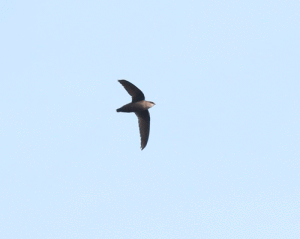
Chimney swifts famously look like cigars with wings.
Chimney Swifts are one of my favorite birds and I eagerly await their return each year in the spring. I love their chattery calls and that is most often how I am alerted to their presence. When I was first learning about birds, they were described to me as a cigar with wings. They do look like that with their slender tube-shaped body and long narrow curved wings. Those stiff curving wings give then a unique flight style that make them easy to recognize and their aerial acrobatics are fun to watch as they forage for insects in the sky.
Chimney Swifts spend most of their time in the air, and when they perch it is on the side of a chimney, tree hollow, or other upright structure. In fact, they are unable to perch horizontally like other birds. Their short legs, small feet, strong toes and sharp claws aid them in this upright perching style.
While aloft, they forage for insects including flies, bees, wasps, ants, beetles, fleas and most any type of flying insect they can find. They feed over urban and rural habitats alike. Anywhere you find flying insects, you can find Chimney Swifts.
They are common in towns because they use chimneys and other human structures for nesting and roosting. Their populations probably expanded greatly with the coming of European settlements but chimneys are now becoming less common and are often capped, making them inaccessible. So the birds are being pushed back into more traditional nesting habitats such as dead trees, caves, or cliff faces.
The Chimney Swift Conservation Association promotes the creation of nesting and roosting sites with plans on how to build a Chimney Swift tower. We have one at Gulf Coast Bird Observatory and each year a pair of swifts nests there!
Chimney Swifts engage in some really cool aerial courtship displays with the pair flying close together and calling. Then, suddenly, they put their wings into a V shape and glide downward together in a curve before starting all over again.
Once paired, these birds build their nest of loosely woven twigs and sticks stuck together with their glue-like saliva and glued to the wall of the chimney or other structure. They lay three to five eggs and incubate them for up to 21 days. The young are able to fly in another 20 days.
Although they may tolerate unmated swifts sharing their chimney, there will only be one mated pair per chimney or other nest site. Once nesting is complete however, Chimney Swifts gather together in large flocks that roost together at night. It is an amazing sight to see them all flying into a chimney at dusk as if the chimney was vacuuming them out of the sky.
In the fall they migrate to South America for the winter and I wait for them to return each spring! Spring has now sprung, so keep an eye out for those flying cigars!
